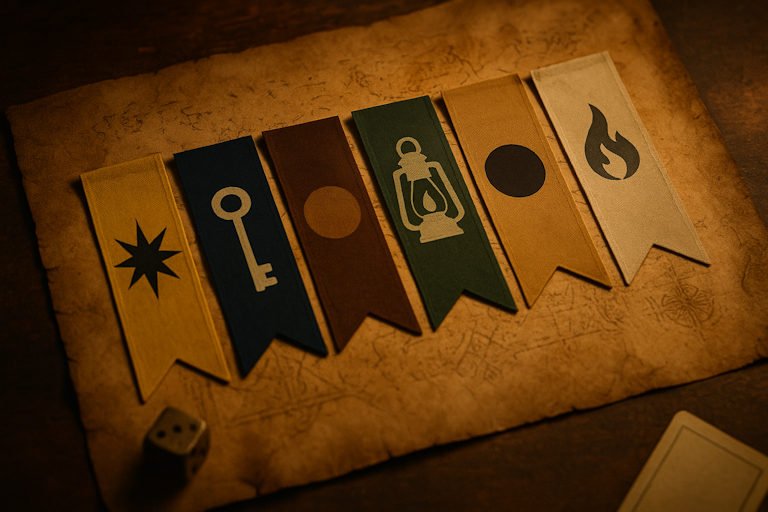
The fascinating psychology of secrecy in storytelling games (2025)
Secrets have always been at the heart of great stories. From hidden letters in old novels to veiled identities in modern films, secrecy is the spark that keeps audiences leaning forward. Storytelling games draw from that same tradition: they thrive on what is concealed, what is whispered, and what remains just out of reach.
In these games, players are not only witnesses to a narrative — they are participants who carry secrets of their own. A hidden role, a sealed objective, or a clue that only one person knows can change the entire dynamic. Suddenly, trust becomes fragile, alliances uncertain, and every choice layered with meaning. The tension does not come from spectacle or violence, but from silence, suggestion, and subtle revelation.
This article explores the fascinating psychology of secrecy in storytelling games. We’ll look at why hidden information heightens engagement, how it reshapes trust, and which techniques make secrecy both fair and thrilling. In the end, secrecy is more than a mechanic: it is a powerful force that transforms simple play into unforgettable stories.
The fascinating psychology of secrecy in storytelling games
Secrecy in storytelling games is not just a mechanic — it is a psychological engine that drives curiosity and emotion. From the very first hidden role or concealed clue, players become more alert, more invested, and more aware of each other. The act of holding or discovering a secret activates the same cognitive triggers that make mysteries and thrillers so compelling: anticipation, uncertainty, and the irresistible need to know what lies beneath the surface.
At its core, secrecy works because humans are hardwired to seek patterns and explanations. When part of the picture is missing, the mind fills the gaps, creating tension and focus. In storytelling games, this means that even a small piece of hidden information can change how players interpret every move at the table. A sealed envelope, a mysterious symbol, or an unrevealed objective pulls the group into a shared sense of “what if.” This tension fuels imagination without requiring dramatic visuals or complex mechanics.
The emotional weight of secrecy is also powerful. Players entrusted with a hidden role or secret mission often experience heightened engagement: they lean into the story, guard their knowledge, and enjoy the thrill of subtle deception. On the other side, those without access to the secret are equally engaged, scanning behavior, questioning motives, and piecing together fragments of information. This dual experience ensures that secrecy does not isolate players but connects them through a dynamic web of suspicion, trust, and discovery.
Most importantly, secrecy turns storytelling into something personal. Because players carry knowledge that others do not, every reveal feels like a revelation crafted just for that moment. These reveals are rarely forgotten: the gasp when a hidden identity is exposed, the laughter when a false lead collapses, the silence before a sealed clue is opened. By weaving secrecy into the design, storytelling games create unforgettable emotional peaks — the kind of moments that transform ordinary sessions into lasting memories.

Uncover
The Firefly Inn
Behind its lantern light, secrets wait to be revealed. Step closer, and choose your path into the unknown.
How secrecy shapes engagement and trust
The presence of secrecy changes not only the mechanics of a game, but the way people interact with each other. Hidden information shifts attention away from the board or story elements and onto the players themselves. Every hesitation, every glance, every unusual move can be read as a clue. This heightened awareness transforms even simple actions into moments of suspense.
Engagement rises because secrecy sparks constant interpretation. Players no longer respond only to the rules; they respond to one another. The uncertainty creates a sense of vigilance: who can be trusted, and who might be hiding something? This dynamic is why games with secret objectives or concealed roles often feel more intense than purely open systems. Players are not only participating in a narrative but also decoding the social behavior around them.
Trust becomes both fragile and fascinating under these conditions. A single hidden card or sealed mission can reshape alliances in an instant. Groups often find themselves laughing, accusing, or second-guessing decisions based on the smallest cues. The paradox is that secrecy both destabilizes trust and makes it more meaningful. When confidence is earned despite hidden information, it feels stronger; when betrayal is revealed, the emotional impact is sharper.
From a psychological perspective, secrecy heightens empathy as well. Players project themselves into the minds of others, trying to imagine motives and strategies that are not openly shared. This process mirrors real-world social interactions, where incomplete information is the norm. Storytelling games harness this human tendency, turning it into a source of fun, tension, and collective storytelling.
Yet secrecy must be handled with care. If hidden elements feel unfair or impossible to uncover, engagement can collapse into frustration. The key lies in designing secrets that are discoverable, or at least interpretable, through observation and interaction. This ensures that the thrill of secrecy enhances the story rather than undermines it. When done right, secrecy not only keeps players engaged but weaves them together in a web of trust, suspicion, and shared discovery.

Uncover
The Firefly Inn
Behind its lantern light, secrets wait to be revealed. Step closer, and choose your path into the unknown.
Mechanics and techniques that use secrecy to enhance play
Secrecy thrives when it is more than a gimmick. In storytelling games, it works best when tied to mechanics that naturally create tension and anticipation. Below are some of the most effective approaches that designers and players can use to build deeper engagement.
- Hidden roles: Assigning players secret identities immediately changes dynamics. Suspicion and deduction become central, and every reveal reshapes the narrative.
- Sealed objectives: Giving each player a private mission ensures that not all goals are visible. This hidden layer of purpose drives unexpected moves and alliances.
- Clue distribution: No single player holds all the pieces. Information is scattered across the group, forcing collaboration while keeping uncertainty alive.
- Misdirection mechanics: Systems that allow false hints or red herrings heighten mystery. Players must separate truth from illusion, which keeps them constantly engaged.
- Gradual revelations: Secrets that unfold over time — like opening envelopes or unlocking story cards — create a rhythm of suspense and payoff.
- Restricted knowledge environments: Fog-of-war maps, coded notes, or limited visibility elements build immersion. The unknown becomes part of the game world itself.
- Conditional secrets: Information that only triggers under specific circumstances (like a hidden rule or a character ability) creates anticipation and replay value.

Together, these mechanics show that secrecy is not just a layer on top of the story but an integral design choice. When handled thoughtfully, secrets draw players deeper into the narrative, ensuring that every revelation feels earned and unforgettable.
Balancing secrecy and fairness
Secrecy can transform storytelling games into unforgettable experiences, but only if it is handled with balance. Hidden roles, sealed clues, and private objectives build tension, yet if players feel manipulated or excluded, the effect quickly turns sour. The challenge is ensuring that secrecy enhances the story without undermining trust.
Fairness begins with clarity. Players do not need to know every detail, but they should believe the game operates within consistent boundaries. If a secret objective feels impossible to achieve or if a hidden twist breaks the logic of the story, frustration replaces excitement. Designers and hosts must ensure that secrets fit seamlessly into the rules and narrative, so that each revelation feels like a natural part of the experience.
Timing is just as important as design. Too many secrets revealed at once can overwhelm players, while too few can make the game feel flat. The best storytelling games pace their mysteries, offering just enough information to keep curiosity alive. A steady rhythm of small discoveries, punctuated by occasional big reveals, allows secrecy to build tension without exhausting the group.
Social dynamics also shape how secrecy is received. Some players love deception and deduction, while others prefer transparency. Offering layers of secrecy — optional clues, shared hints, or parallel storylines — gives everyone a way to engage without forcing discomfort. Fair secrecy means leaving space for different playstyles, so that no one feels left behind.
In the end, secrecy is a tool, not a trap. When used with fairness, it binds players together in shared anticipation, turning every clue into a step toward discovery. And when the balance is right, secrecy doesn’t divide the group — it makes the story stronger.
Conclusion: Why secrecy in storytelling games keeps players hooked
Secrecy in storytelling games is more than a clever design trick — it is the force that turns ordinary play into lasting memory. By holding back information and revealing it at the right moment, games tap into deep psychological patterns: curiosity, anticipation, and the thrill of discovery. These moments stay with players not because of points or victory, but because of the emotions they spark.
What makes secrecy so powerful is its ability to connect players through shared uncertainty. A hidden role, a sealed card, or a subtle clue transforms the table into a stage where trust, suspicion, and imagination collide. When the reveal finally comes, the laughter, gasps, or silence that follow become the heartbeat of the story. It is this collective reaction — not the mechanics themselves — that makes the experience unforgettable.
Yet the true strength of secrecy lies in balance. When secrets feel fair and integrated into the game’s logic, they enhance rather than frustrate. They invite players to lean forward, speculate, and weave their own interpretations into the narrative. The result is immersion: a story that feels alive because it is shaped by what remains hidden until the right moment.
Ultimately, secrecy in storytelling games proves that the most powerful tools are often the quietest. It is not the spectacle but the silence, not the obvious but the concealed, that lingers longest. And in those concealed moments, games reveal their greatest gift: stories that players carry long after the session ends.

Uncover
The Firefly Inn
Behind its lantern light, secrets wait to be revealed. Step closer, and choose your path into the unknown.




